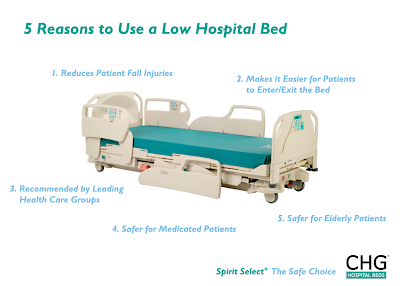5 Reasons to Use a Low Hospital Bed
When it's time to purchase new hospital beds for your facility, consider a low hospital bed. Specifically designed with patient safety and comfort in mind and recommended by leading health care groups, low hospital beds can be a valuable component of your hospital's fall prevention strategies.
Here are 5 reasons why your facility should use low hospital beds:
2. Low hospital beds make it easier for patients to enter and exit the bed
3. Low hospital beds are recommended by leading health care groups
4. Low hospital beds are safer for medicated patients
5. Low hospital beds are safer for elderly patients
Here are 5 reasons why your facility should use low hospital beds:
 |
| Click to Enlarge |
1. Low hospital beds reduce patient fall injuries
Patient falls are the largest category of reported incidents
in hospitals and account for approximately 70-80% of all inpatient incidents,
and a reported 22% of these falls are from the bed. Statistically speaking, all
hospital units will experience an inpatient fall at some point in time.
Low hospital beds help reduce patient fall injuries by
lowering the patient’s resting position to as low as 10” from the ground. A low
resting height can reduce fall impact and can help prevent serious injuries
such as hip fractures and brain injuries. Fall injury risk is significantly
reduced at a safe and comfortable resting position, which can also increase
patient confidence and mobility.
2. Low hospital beds make it easier for patients to enter and exit the bed
A traditional
hospital bed’s lowest height can be upwards of 20”, which can make it difficult
for patients to enter and exit the bed. A fully adjustable low hospital bed can
lower to an appropriate height for patients to safely enter and exit without
needing to climb or jump onto the bed. The ideal low hospital bed is
specifically designed for patients to be able to sit at the side of the bed
with their feet planted on the floor to safely enter or exit the bed.
3. Low hospital beds are recommended by leading health care groups
Low hospital beds have been recommended for use by the
Centers for Medicare & Medicaid Services (CMS), the VA National Center for
Patient Safety, and The Joint Commission, amongst other leading health care
groups.
The Centers for Medicare & Medicaid Services has
included patient falls as one of 10 Hospital-Acquired Conditions that can be
reasonably prevented by following evidence-based guideline resources. The CMS’
own evidence-based guideline recommends that hospital facilities first assess
patients for fall risk and then utilize low hospital beds that achieve a low
height between 8-10”. The CMS also cites the example of one large health care
system using low hospital beds, successfully reducing the facility’s patient
fall rate by 9%.
The VA National Center for Patient Safety has recognized low
hospital beds as an integral component in creating a “safe room” for veterans
and has identified low hospital beds as a top strategy for reducing inpatient
fall injuries.
The Joint Commission’s 2012 Hospital Accreditation Standards
now requires hospitals to assess patient fall risk and to implement strategies
to reduce falls based on the assessment. Low hospital beds were previously recommended
in a Joint Commission Sentinel Event Alert as a risk reduction strategy for
patients at-risk for falls.
For more information, visit U.S. Department of Health & Human Services Agency for Healthcare Research and Quality,
United States Department of Veterans Affairs National Center for Patient Safety,
and The Joint Commission Sentinel Event Alert.
4. Low hospital beds are safer for medicated patients
The use of medication may cause dizziness and
disorientation, which can increase a patient’s risk of falling from bed. A
medicated patient may become confused and unaware of his surroundings, which
can lead to an attempt to exit the bed without nurse assistance. A lower bed
height can minimize fall injury and create a safer environment for patients who
are prone to wandering or exiting the bed unassisted. The ideal low hospital
bed for any acute care facility is equipped with an integrated multi-zone
bed-exit alarm, which can alert nurses to bed-exit activity to intercept
wandering or falls and create an even safer patient environment.
5. Low hospital beds are safer for elderly patients
As baby boomers continue to age and enter the prime
demographic for chronic disease, hospitals will experience an influx of senior
patients. By 2030, it is estimated that patients over the age of 65 will make
up 51% of admissions and 59% of all occupied hospital beds. In acute care
facilities, it is estimated that 1 in 5 elderly patients will fall during their
stay. For this reason, the safety of elderly patients should be a top priority
for health care professionals.
Elderly patients
often experience mobility problems and cognitive disorders, which have been
identified as leading risk factors for patient falls. The low resting height of
low hospital beds creates a safer environment for elderly patients who may have
difficulty exiting the bed or who may be experiencing memory loss or confusion.
For information on the CHG Spirit Select, the lowest acute care hospital bed on the market, visit www.chgbeds.com.
Related posts:
Related posts:
CHG Hospital Beds specializes in low hospital beds that are designed to prevent patient falls and related injuries within acute care environments. We are focused on patient and nurse safety and deliver innovative solutions to meet the needs of our customers.
Labels: 5 reasons, chg hospital beds, low hospital bed, patient safety, spirit select









5 Comments:
hospital beds
Thanks for your great blog. I am very pleased to read this blog. This blog is very helpful for us.
I know Hospital beds at great prices is
very important for us.
Post a Comment
Subscribe to Post Comments [Atom]
<< Home